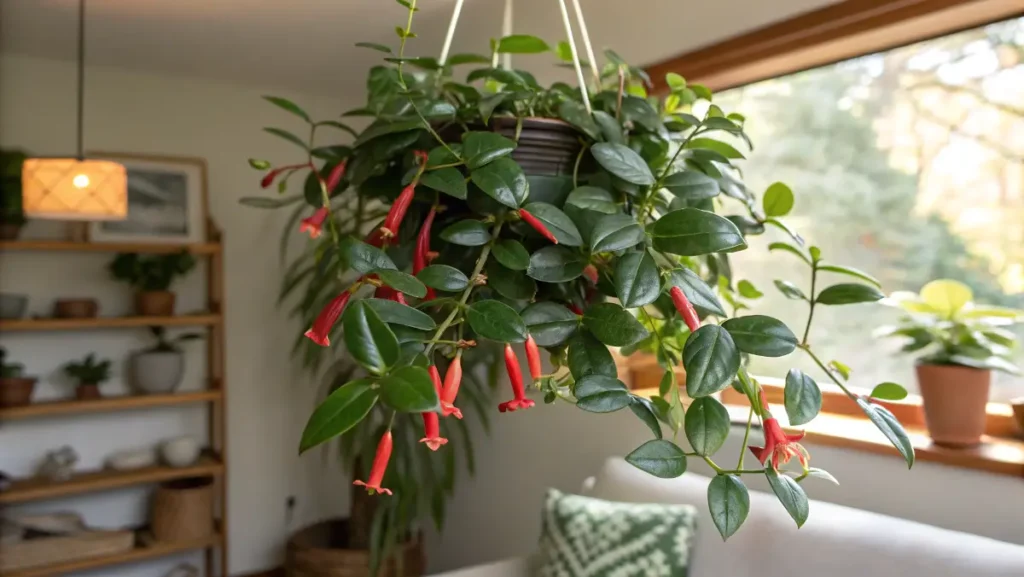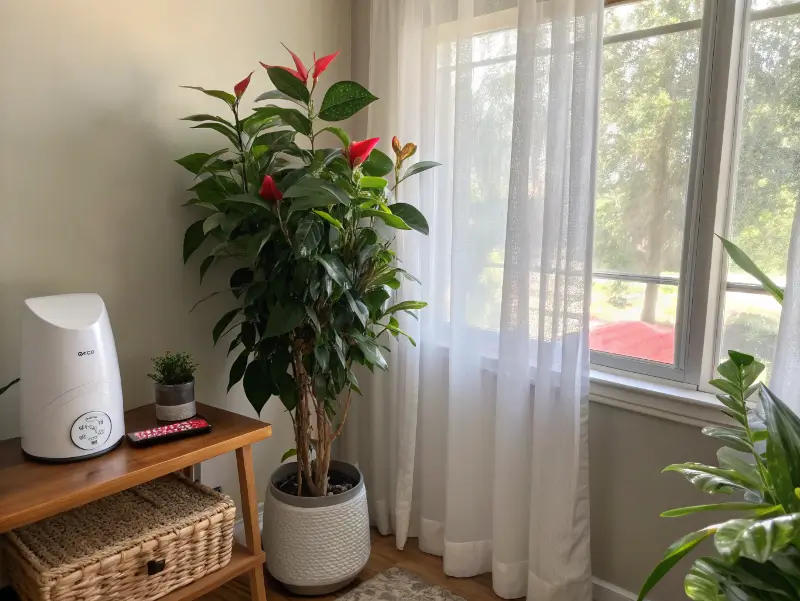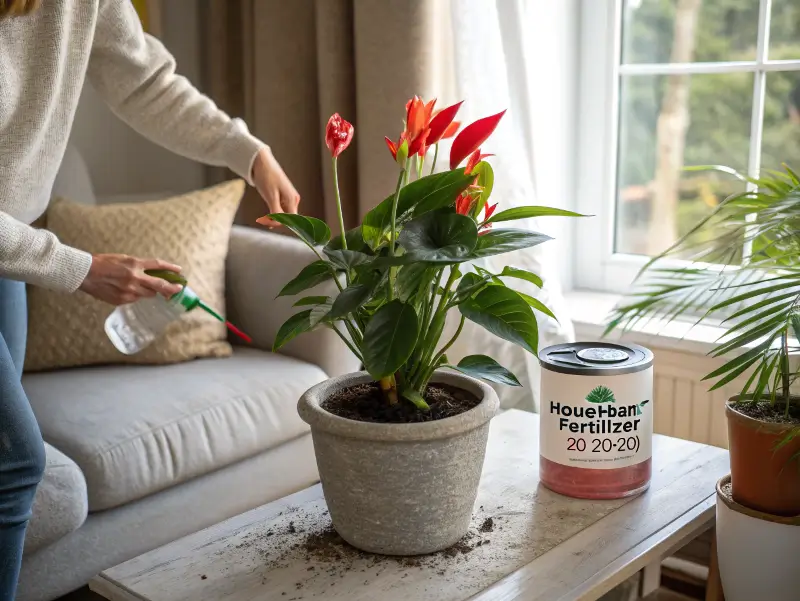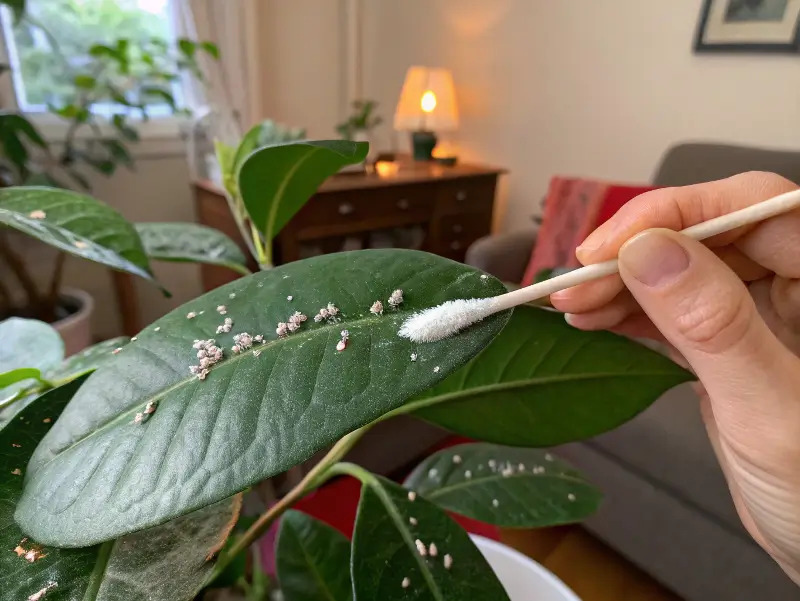
I’m thrilled you’re here to chat about the lipstick plant with me. As we move into spring, many folks have been looking for vibrant, easygoing houseplants that add a pop of red charm to their rooms. In this post, I’ll share my love for all things lipstick plant. I’ll show you how to identify these beauties, how to grow them without fuss, and how to spot common pitfalls. We’ll also talk about fun ways to display them and keep them looking fresh. If you’re as plant-obsessed as I am, you’ll find simple tips that fit right into your busy life.
Table of Contents
Introduction to the Lipstick Plant
What Is a Lipstick Plant?
I remember when I first spotted a lipstick plant peeking out in my neighbor’s window. Honestly, I was struck by those fiery, tube-shaped blooms that seemed to emerge from little pockets—kind of like a fresh tube of lipstick! To be clear, the scientific name is Aeschynanthus radicans, but you’ll hear many plant lovers call it simply lipstick plant.
- Origin: Tropical regions of Asia
- Growth habit: Trailing or cascading vines
- Bloom style: Vibrant red blooms shaped like lipstick tips
I’ve been hooked ever since I brought one home, you know?
Why It’s Huge Right Now
We live in an era where bright houseplants are trending on Instagram like crazy. Everyone wants a living statement piece, and that’s exactly what a lipstick plant delivers. Its flashy blooms draw attention, and the trailing vines look amazing on high shelves or in hanging baskets.
Key Characteristics and Varieties
Notable Traits
Most lipstick plants have thick, shiny leaves that hold water well. Meanwhile, their flowers slip out from tube-shaped sheaths—resembling a lipstick bullet. Because they hail from humid, warm environments, they do best with moderate watering and bright, but indirect, light.
- Leaves: Glossy or slightly fuzzy
- Blooms: Red, tubular, often cluster in groups
- Growth rate: Relatively fast with proper care
Different Varieties
While the plain green version is most common, you’ll also find the twisted lipstick plant that sports curly leaves. I’ve seen some folks rave about that playful form, saying it makes the plant even more eye-catching. Also, certain cultivars have variegated leaves or slightly different bloom colors, but red remains the classic. If you’re the type who appreciates options, you could collect multiple lipstick plants for a dramatic indoor jungle. My cousin tried that, and now her window sills look like a mini tropical paradise!
Choosing the Right Environment for Lipstick Plants

Indoor vs. Outdoor
Some people ask if the lipstick plant should stay inside or outside. The short answer is: both can be fine! However, if your region has harsh winters, bringing it indoors is safer. Temperatures below 60°F can stress the plant or slow growth.
- Indoors: Bright, filtered sunlight near a window
- Outdoors: Partial shade, away from scorching direct sun
- Seasonal changes: Bring it inside if temps drop below 60°F
Temperature and Humidity
Think of the tropics—warm and slightly humid. When I keep the humidity around 50%, I see better blooms. You might:
- Mist the leaves lightly
- Place a humidity tray under the pot
- Group plants to share moisture in the air
If your home is super dry, a small humidifier can be a game-changer for lipstick plant care. Because we’re all busy, it helps to find easy ways to keep humidity up. That extra moisture will help those flowers stay perky.
Planting and Lipstick Plant Propagation Techniques
Seeds vs. Cutting
I’ve tried seeds before, but lipstick plant propagation from cuttings is quicker and more reliable. Seeds can be slow, and germination isn’t always guaranteed. Meanwhile, a freshly snipped stem with a few leaves can be rooted in about a month.Steps for Cutting Propagation
- Select a healthy stem with a few leaves.
- Cut just below a leaf node.
- Strip lower leaves, leaving only top foliage.
- Place the cutting in water or directly into moist potting mix.
- Keep the environment warm with indirect sunlight.
I enjoy sticking cuttings in a glass of water because I can watch the roots develop. It’s oddly satisfying, you know? Once the roots look substantial—around two inches long—I move them to soil. If you’d rather skip the water phase, simply pop your cutting into a well-draining mix of peat and perlite. Keeping the soil moderately damp encourages strong roots. With lipstick plant propagation, you can multiply your plants and share them with friends or family. Just be careful not to overwater, as that can bring on rot.
Watering and Feeding Your Lipstick Plant Care

Proper Watering
Let’s face it: overwatering is a common mishap that can ruin a lipstick plant. I usually let the top inch of soil dry out before I water. Then, when I do water:
- I make sure it drains through the bottom.
- I discard any excess in the saucer.
- I keep a watchful eye for yellow leaves.
If leaves are yellow or mushy, pull back on watering. Honestly, it might not be your fault either—some potting mixes hold more moisture than others.
Feeding for Lush Growth
For lipstick plant care, I find that a balanced houseplant fertilizer, applied at half strength, every two weeks in spring and summer works wonders. If you prefer an organic route:
- Try diluted fish emulsion
- Consider worm castings mixed into the potting soil
During fall and winter, scale back or skip the fertilizer because growth naturally slows. If your plant still throws out new shoots, a light feeding once a month is fine. Watch for signs like leggy growth or pale leaves. That might mean your plant craves a bit more food. It’s not rocket science—just pay attention to your buddy’s cues.
Pruning and Maintenance for a Happy Twisted Lipstick Plant
Why Prune?
Allow me to say: The twisted lipstick plant can get spindly if left unchecked. Snipping can help keep it bushy and better shaped. Also, pruning worn-out stems after flowering encourages fresh blooms.Pruning Tips
- Cut just above a leaf node
- Use clean, sharp scissors
- Remove dead or discolored leaves promptly
Basic Maintenance
Give leaves a gentle wipe with a damp cloth to clear away dust. This simple step helps the plant soak up the right amount of light. Moreover, rotating the pot every week or two ensures even light exposure. That way, your twisted lipstick plant won’t lean to one side.If you see roots peeking out the bottom, consider moving the plant into a slightly larger pot.
Pick a container that’s about one or two inches bigger, so roots have a bit of extra space. However, don’t go too large. Extra soil can hold moisture and potentially bring on issues like root rot. Keep it snug but comfortable.
Common Pests and Diseases

Typical Bugs
Occasionally, aphids, mealybugs, or spider mites think your lipstick plant is an all-you-can-eat buffet. If you notice:
- White, fuzzy clusters (mealybugs)
- Tiny webs under leaves (spider mites)
- Sticky residue (aphids)
it’s time for action. I isolate the plant first, so pests don’t jump to other houseplants. Then, I wipe leaves with soapy water or spritz with a neem oil solution.
Root Rot and Other Problems
Root rot happens when the soil stays soggy. Cut back on watering, and make sure your pot drains well. If the plant looks droopy, gently remove it from the pot and check the roots. Trim off rotten or dark patches, then re-pot in fresh mix. In severe situations, you might salvage a healthy cutting and start new lipstick plant propagation.
Meanwhile, keep an eye out for leaf scorch if your buddy is too close to direct sun. Moving it a few inches away from a hot window can fix that. For more info on natural methods, you can check the U.S. Department of Agriculture, which often shares tips about eco-friendly pest control.
Encouraging Profuse Blooms on Your Lipstick Plant
Seasonal Flowering
During spring and summer, a well-cared-for lipstick plant might explode with color. However, do not be shocked if flowers also appear outside those seasons when conditions are right. A stable environment helps:
- Warm temps around 70–80°F
- Humidity at least 50%
- Light feeding schedule
By the way, if you see buds forming, try not to move the plant too much. Sometimes, abrupt changes in location make buds drop prematurely.
Tips for Maximizing Blossoms
I’ve realized that a bit of tough love at the start of spring can help. Slightly cooler nights, especially after winter, seem to tell the plant, “Hey, time to produce some showy blooms!” Additionally:
- Rotate the pot so each side gets even light
- Clip the plant lightly after a big bloom flush
- Avoid heavy fertilizer once the buds appear
Because they’re epiphytes in the wild, they’re used to partial light filtering through a canopy. Thus, direct blazing sun might scorch leaves or bleach those shiny green tops. I’ve had more success near a bright window with sheer curtains. Plus, checking the soil every few days helps me keep a consistent routine. It’s all about small, regular efforts that make the lipstick plant thrive.
Designing and Displaying Your Lipstick Plant
Hanging Baskets for Style
The drama of a lipstick plant in a hanging basket is A+. Vines will spill over the edges, letting those red blossoms dangle in midair. I often see pictures on social media of these plants matched with trendy macramé hangers. You could also set them high on a shelf, so the vines drape elegantly.
- Baskets with plenty of drainage
- Rotate weekly for balanced light
- Combine with other trailing plants for variety
Fun Home and Garden Combos
I like showcasing multiple lipstick plants near walls painted white or soft gray. The bright red really pops. If you’re looking for a color combo, consider placing them next to the Black Dahlia Flower. The contrast can be mind-blowing during blooming season. Also, you can team it with a Spider Plant to create a small green family. Outdoors, partial shade works well if your weather is mild.
Just remember to bring them in before winter chills arrive, or else they might get sad and drop leaves.Honestly, I get excited thinking about how easy it is to transform a dull corner into a tropical nook with a single lipstick plant. It’s that striking.
Lipstick Plant FAQs
How do you care for a lipstick plant?
I hear this question a lot, and the basics are:
- Medium to bright indirect light
- Moderate watering, letting the top inch of soil dry
- Temp range of about 60–80°F
- Light fertilizer during the warm months
When you nail these steps, you’ll see your buddy flourish. Over time, lipstick plant care also includes pruning dead stems, wiping the leaves, and rotating the pot.
Is a lipstick plant indoor or outdoor?
It can thrive in both settings. However, many folks keep it indoors, especially if winters get cold. Since early 2025 is still a bit nippy in some places, I’d keep the plant inside until nights stay consistently above 60°F.
Is the lipstick plant poisonous to dogs?
It’s generally considered non-toxic if Fido decides to nibble. Still, it’s wise to keep all houseplants out of a curious pup’s reach. Each dog’s stomach reacts differently.
How often does a lipstick plant bloom?
In spring and summer, you can expect bursts of color. But if lipstick plant care is spot on, flowers might pop up all year. Keep an eye on light, temperature, and feeding routines, and you might get a pleasant surprise in the off-season.
Helpful Tips & Tricks
Because I’m all about quick shortcuts, here’s a lightning round of advice:
- Check soil moisture: Don’t rely on guesswork. Stick a finger in the soil or use a moisture meter.
- Mist with caution: Don’t soak the leaves too heavily. A light mist is best if air is dry.
- Use a balanced houseplant fertilizer: 20-20-20, half-strength, every two weeks in spring and summer.
- Pair with other tropical lovelies: A twisted lipstick plant looks spectacular next to ferns or peace lilies.
- Watch the light: If leaves start to fade, you might move it a bit closer to a bright window.
A consistent routine builds a happy relationship with your lipstick plants. Trust me, I learned that if I ignore them for weeks, they droop. But if I check in every few days—kind of like how I text friends—they stay perky.
Why Twisted Lipstick Plant Leaves Curl
If you’ve seen the twisted lipstick plant, you know it has those funky, curled leaves. People often ask why they curl:
- Genetics: Some cultivars are bred that way.
- Environmental triggers: Slight fluctuations in light or humidity enhance the curl.
- Stress: Too much or too little water can lead to leaf curling, so keep a balanced schedule.
I’ve noticed that my twisted lipstick plant looks the most twisted when it’s kept slightly pot-bound and in a moderately bright area. Moreover, these curls give it that whimsical look you’d see in a Tim Burton film—kinda wild and unpredictable. Meanwhile, it’s still the same reliable lipstick plant, just with a twist. If leaves flatten unexpectedly, check your humidity and watering routine. Small adjustments often bring the curls back before you know it.
Final Thoughts and a Quick Recap
At this point, you’ve got the lowdown on the lipstick plant. We covered important stuff like:
- Lipstick plant propagation shortcuts
- Watering and feeding methods
- Pest control ideas
- Ways to encourage better blooms
- Decorating tips for maximum impact
If you stay consistent, keep an eye on humidity, and prune as needed, your lipstick plant will reward you with bright red blossoms that make friends say, “Hey, what is that gorgeous plant?”For more gardening tips, you can explore other official resources online or check out actual case studies from everyday plant lovers. Meanwhile, keep building your own indoor jungle. Perhaps next time, I’ll share stories about large philodendrons or succulent corners—who knows? The plant world is full of surprises, and it’s never boring.

3 thoughts on “Lipstick Plant : Expert Growing and Caring Guide”
Comments are closed.